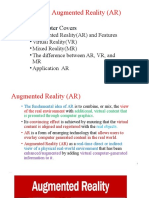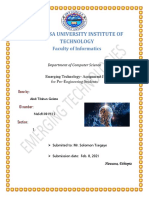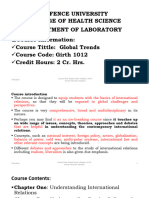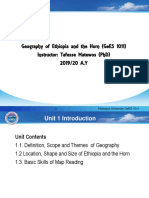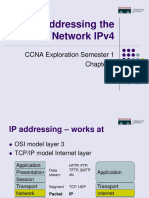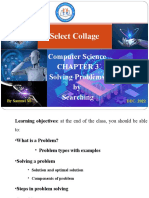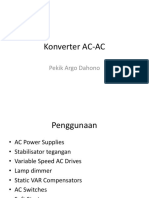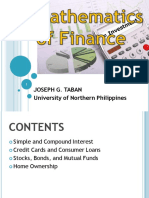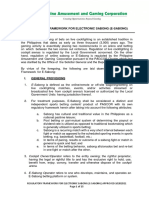Undergraduate Program
Accounting Department
INTRODUCTION TO EMERGING TECHNOLOGIES
Chapter one
Instructor: Samuel M.
03/23/2023
Introduction to Emerging Technology 1
Chapters Content
Chapter-1: Introduction(overview)
Chapter-2: Introduction to Data Science
Chapter-3: Artificial Intelligence(AI)
Chapter-4: Internet of Things (IoT)
Chapter-5: Augmented Reality (AR)
Chapter-6: Ethics and Professionalism of Emerging Technologies
Introduction to Emerging Technology 2
Assessment
Class Test/mid : 30%
Assignment : 20 %
Final Exam: 50%
Assignments may in group or individual
Student with class absence more than 15% will not
seat for final exam
Introduction to Emerging Technology 3
Introduction to Emerging Technologies
Topics Covered
Evolution of technologies
Introduction to Industrial revolution
Historical background (IR 1.0, IR 2.0, IR 3.0 and IR 4.0)
Agricultural and Information revolution
Role of data for Emerging technologies
Enabling devices and networks for emerging technologies
(programmable devices)
Human to Machine Interaction
Future trends in emerging technologies
Introduction to Emerging Technology 4 03/23/2023
What is Emerging Technologies?
Emerging technology is a term generally used to describe a new
technology, but it may also refer to the continuing development of an
existing technology.
The term commonly refers to technologies that are currently
developing, or that are expected to be available within the next five
to ten years that are creating or are expected to create significant
social or economic effects.
Technological evolution is a theory of radical transformation of
society through technological development.
Introduction to Emerging Technology 5 03/23/2023
What is the root word of Technology and Evolution?
Technology:1610s, derived from Greek tekhnologia "systematic
treatment of an art, craft, or technique,"
Originally from tekhno- + -logy means
“ Science of the mechanical & industrial arts" first recorded in 1859.
Evolution: evolution means the process of developing by gradual
changes. This noun is from Latin evolutio, “an unrolling, rolling
out or opening.”
Introduction to Emerging Technology 6 03/23/2023
INTRODUCTION (2)
We can divide revolution of technolog y based on theoretical change in
human being life into 4 groups.
Those are:
Agricultural revolution (First r evolution) from 1600.
Industrial revolution (Second revolution) from 1700 -1800
Information revolution (Third revolution)
Knowledge revolution (Fourth revolution) that will come in the future.
Fourth revolution can also call as smart revolution because future’s
revolution will be smart civilization by new knowledge, ICT, AI, and etc.
Introduction to Emerging Technology 8 03/23/2023
AGRICULTURAL REVOLUTION
Agricultural revolution was started from 1600.
Human being make a life with a hunting, getting a catch fruit and
vegetable, and others.
This life style continues to agriculture and settles down at one place.
This life style continues till first agriculture revolution.
However, this life style of human being had been end up because the
agricultural revolution was developed through plant and crop at one
place.
Introduction to Emerging Technology 9 03/23/2023
TIMELINE OF THE AGRICULTURAL REVOLUTION
First agricultural revolution:
The first agricultural revolution is the period of transition
from a hunting-and-gathering society to one based on
fixed farming.
The technology developed for this period includes
simple metal tools to cultivate the land/harvest.
Second agricultural revolution:
The second agricultural revolution went hand in hand
with the Industrial Revolution in the 18th and early 19th.
Introduction to Emerging Technology 10 03/23/2023
TIME LINE OF AgRev. CONT…
New technology was introduced to agriculture for mass crop.
Farmers were no longer to limited farms and commercial
farming became an idea worth exploring.
The technology developed for this revolution includes the seed
drill, which enabled farmers to easily plant rows, new fertilizers
were also introduced as well as artificial feed.
Introduction to Emerging Technology 11 03/23/2023
TIMELINE OF AgRev. CONT…
Third agricultural revolution:
The green revolution was the introduction of advanced
technology and agricultural practices to farms to make farms
more efficient.
This revolution was sparked by the increasing awareness that
the earth is not renewable and that farms could not keep
expanding outward and efficiency of land.
Introduction to Emerging Technology 12 03/23/2023
TIMELINE OF AgRev. CONT…
Fourth agricultural revolution:
The current agriculture is changing because of AI and ICT.
This means, AI and ICT is introducing to agriculture to
analyze and adjust humidity, temperature without weather
condition.
Current agriculture do not have competitiveness without
recognition of customer’s taste.
Introduction to Emerging Technology 13 03/23/2023
INDUSTRIAL REVOLUTION (1)
The industrial revolution took place during the late 1700s and
early 1800s.
The industrial revolution began in Great Britain and quickly
spread throughout the world.
This revolution affected social, cultural, and economic conditions.
This revolution left a deep impact on how people lived and the way
businesses operated as well as the creation of capitalism and the
modern cities of today.
Introduction to Emerging Technology 14 03/23/2023
INDUSTRIAL REVOLUTION (2)
The M o s t Important Inventions of the Industrial Revolution are:
Transportation: The Steam Engine, r ailway, Diesel engine, Airplane.
Communication: The Telegraph, Intercontinental cables, Phonograph,
Telephone etc.
Industry: The Cotton gin, Sewing Machine, Electric Lights etc.
Introduction to Emerging Technology 16 03/23/2023
TYPES OF INDUSTRIAL REVOLUTION
First Industrial Revolution (IR 1.0)
The Industrial Revolution (IR) is described as a transition to new
manufacturing process
The transitions in the first IR included going from hand
production methods to machines, the increasing use of steam
power, the development of machine tools and the rise of the
factory system.
Introduction to Emerging Technology 17 03/23/2023
STEAM ENGINE
03/23/2023
Second Industrial Revolution (IR 2.0)
IR 2.0 included widespread pre-existing technological systems
such as telegraph and railway networks.
New technological systems were introduced, such as electrical
power and telephones.
The Second IR, also known as the Technological Revolution.
Third Industrial Revolution (IR 3.0)
IR 3.0 introduced the transition from mechanical and analog
electronic technology to digital electronics.
Due to the shift towards digitalization, IR 3.0 was given the
nickname, “Digital Revolution”.
Introduction to Emerging Technology 19 03/23/2023
Third Industrial Revolution (IR 3.0)…
The core factor of this revolution is the mass production and
widespread use of digital logic circuits and its derived
technologies such as the computer, handphones and the
Internet.
Introduction to Emerging Technology 20 03/23/2023
Fourth Industrial Revolution (IR 4.0)
IR 4.0 has advancements in various technologies such as robotics,
Internet of Things (IoT), additive manufacturing and autonomous
vehicles.
These technologies are what you call – cyber-physical systems.
A cyber-physical system is a mechanism that is controlled or
monitored by computer-based algorithms, tightly integrated with the
Internet and its users.
Introduction to Emerging Technology 21 03/23/2023
Any body Connected device (ABCD) or IoT
Introduction to Emerging Technology 22 03/23/2023
INFORMATION REVOLUTION (1)
The information revolution started from invention of broad
cast technology on 1922.
Many information material could be stored on the device and was
manipulated on computer networks.
Their technology allow direct retrieval from any where in the world
and storage at speeds.
During this revolution, individuals can easily communicate with
each other worldwide and share information by using the same
computer networks
Introduction to Emerging Technology 23 03/23/2023
INFORMATION REVOLUTION (1)
The information revolution
Started from invention of broad cast technology on 1922.
Information could be stored on the device and was worked on
computer networks.
The technology allow direct retrieval from any where in the world
and storage at speeds.
Individuals can easily communicate with each other at worldwide
and share information by using the same computer networks
Introduction to Emerging Technology 24 03/23/2023
INFORMATION REVOLUTION (2)
Information revolution was driven by three factors:
Firstly, information-based professions grew throughout the 20th
century. Almost office work distributed with information.
Second, Cheap personal computers spread out information and
materials with user-friendly operating systems.
It enabled vastly more people to make direct and suitable use of
computerized information.
The third factor, it was the Internet that made a central contribution
from the early 1990s.
Service like email, banking, web design, I T surveillance have
been increased.
Introduction to Emerging Technology 25 03/23/2023
INFORMATION REVOLUTION (2)
Information revolution was driven by three factors:
Firstly, from manual to computer
People start to use comp/office works in comp
Second, Cheap personal computers spread out information
Every think is comp with user-friendly operating systems.
Peoples abled to use of computerized information.
The third factor, the Internet that made a central contribution
Service like email, banking, web design, I T surveillance have
been increased.
Introduction to Emerging Technology 26 03/23/2023
Role of Data for Emerging Technologies
We are living in the age of big data.
Data has become the foundation for everything.
It is valuable and strategic asset, and drives
Data can determines the future of science, technology, the economy,
and possibly everything in our world today and tomorrow.
This paradigm-shifting are driven not just by data itself but all other
aspects that could be created, transformed, by understanding,
exploring, and utilizing data.
Introduction to Emerging Technology 27 03/23/2023
ENABLING DEVICES AND NETWORK
( P R O G R A M M A B L E DEVICES)
In the world of digital electronic systems, there are four basic kinds of
devices: memory, microprocessors, logic and networks.
Memory devices: store random information such as the contents of a
spread sheet or database and others.
Microprocessors: execute software instructions to perform a wide
variety of tasks such as running a word processing program or others
Logic devices: provide specific functions, including device-to-device
interfacing, data communication and control operations, and function a
system must perform.
Introduction to Emerging Technology 28 03/23/2023
Programmable Logic Device
Programmable: a general class of devices can be configured to
perform a variety of logic functions.
Logic devices: into two broad categories - Fixed and Programmable
Introduction to Emerging Technology 29 03/23/2023
Fixed Logic Devices:
As the name suggests, the circuits in a fixed logic device are
permanent, they perform one function or set of functions - once
manufactured, they cannot be changed.
With fixed logic devices, the time required to go from design, to
prototypes, to a final manufacturing run can take from several months
to more than a year, depending on the complexity of the device.
And, if the device does not work properly, or if the requirements
change, a new design must be developed.
Introduction to Emerging Technology 30 03/23/2023
Programmable Logic Device
A programmable logic device(PLD) is an electronic component
used to build reconfigurable digital circuits. Unlike a logic gate,
which has a fixed function, a PLD has an undefined function at the
time of manufacture.
Before the PLD can be used in a circuit it must be programmed,
that is, reconfigured by using a specialized program.
Simple programmable logic devices (SPLD) are the simplest,
smallest, and inexpensive form of programmable logical devices
Introduction to Emerging Technology 31 03/23/2023
Programmable Logic Device
Most SPLDs use either fuses or non-volatile memory cells
(EPROM, EEPROM, FLASH, and others) to define the functionality.
On the other hand PLDs are standard, off-the-shelf parts that offer
customers a wide range of logic capacity, features, speed, and voltage
characteristics - and these devices can be changed at any time to
perform any number of functions.
With programmable logic devices, designers use inexpensive
software tools to quickly develop, simulate, and test their designs.
Then, a design can be quickly programmed into a device, and
immediately tested in a live circuit.
Introduction to Emerging Technology 32 03/23/2023
Programmable Logic Device…
The PLD that is used for this prototyping is exactly the same PLD that will
be used in the final production of a piece of end equipment, such as:
a network router,
a DSL modem,
a D V D player, or
an automotive navigation system.
Introduction to Emerging Technology 33 03/23/2023
Programmable Logic Device…
Another key benefit of using PLDs is that during the design phase
customers can change the circuitry as often as they want until the design
operates to their satisfaction
That's because PLDs are based on rewriteable memory technology - to
change the design, simply reprogram the device.
Once the design is final, customers can go into immediate production by
simply programming as many PLDs as they need with the final software
design file.
Introduction to Emerging Technology 34 03/23/2023
Programmable Logic Devices (PLDs)
Are digital devices with configurable logic and flip-flops linked
together with programmable interconnect. Logic devices provide
specific functions, including:
Device-to-device interfacing
1. Data communication
2. Signal processing
3. Data display
4. Timing
5. Control operations
6. Almost every other function a system must perform
Introduction to Emerging Technology 35 03/23/2023
Networking
A computer network consists of a number of computers linked
together to allow them to share resources like hardware, software and
data.
Computer networks are very essential to today's globalization as the
world evolves to everything connecting in Information Technology.
One of the key contributing factors of the Information Technology
rise in the world is network and data communication because
technology’s advancement is not only on the gadgets but the system
as well.
Introduction to Emerging Technology 36 03/23/2023
History of Computer Networks
Networking started long ago by ARPANET. An American
military defense fund the project.
The American started an agency named Advance Research
Project Agency (ARPA) and launched their 1st satellite within
18 month after establishment.
Then sharing of the information in another computer they use
ARPANET.
Then in 1969, ARPANET comes in INDIA and INDIAN
switched this name to NETWORK.
After many development, The ARPANET evolved into the
modern Internet.
3
Introduction to Emerging Technology 37 03/23/2023 4
Human to Machine Interaction (1)
Human-machine interaction (HMI) refers to the communication and
interaction between a human and a machine via a user interface.
Nowadays, natural user interfaces such as gestures have gained
increasing attention as they allow humans to control machines
through natural and intuitive behaviors.
What is interaction in human-computer interaction?
HCI (human-computer interaction) is the study of how people
interact with computers and to what extent computers are or are not
developed for successful interaction with human beings.
Introduction to Emerging Technology 38 03/23/2023
Human to M a c hi ne Interaction (2)
As its name implies, HCI consists of three parts: the user, the
computer itself, and the ways they work together.
How do users interact with computers?
The user interacts directly with hardware for the human input and
output such as displays, e.g. through a graphical user
interface(GUI).
The user interacts with the computer over this software interface
using the given input and output (I/O) hardware.
Introduction to Emerging Technology 39 03/23/2023
Human to Machine Interaction (3)
How important is human-computer interaction?
The goal of HCI is to improve the interaction between
users
and computers by making computers more user- friendly and
receptive to the user's needs.
The main advantages of HCI are simplicity, ease of deployment
& operations and cost savings for smaller set- ups.
They also reduce solution design time and integration
complexity.
Introduction to Emerging Technology 40 03/23/2023
Human to Machine Interaction (4)
Disciplines Contributing to Human-Computer Interaction
(HCI):
Cognitive psychology: Limitations, information
processing,
performance prediction, cooperative working, and
capabilities.
Computer science: Including graphics, technology,
Prototyping tools, user interface management
systems.
Linguistics: study of language in context of soc, cult, etc.
Engineering and design: design and build machines.
Artificial intelligence and Human factors.
Introduction to Emerging Technology 41 03/23/2023
Future Trends in Emerging
Technologies
Emerging technology trends in 2019
5G Networks
Artificial Intelligence (AI)
Blockchain
Augmented Analytics
Digital Twins
Enhanced Edge Computing and
Immersive Experiences in Smart Spaces
Some emerging technologies that will shape the future of you
and your business: Chatbots, virtual/augmented reality,
blockchain, Ephemeral Apps and Artificial Intelligence are
already shaping your life whether you like it or not.
Introduction to Emerging Technology 42 03/23/2023
End of the Chapter
Thank You!
03/23/2023











